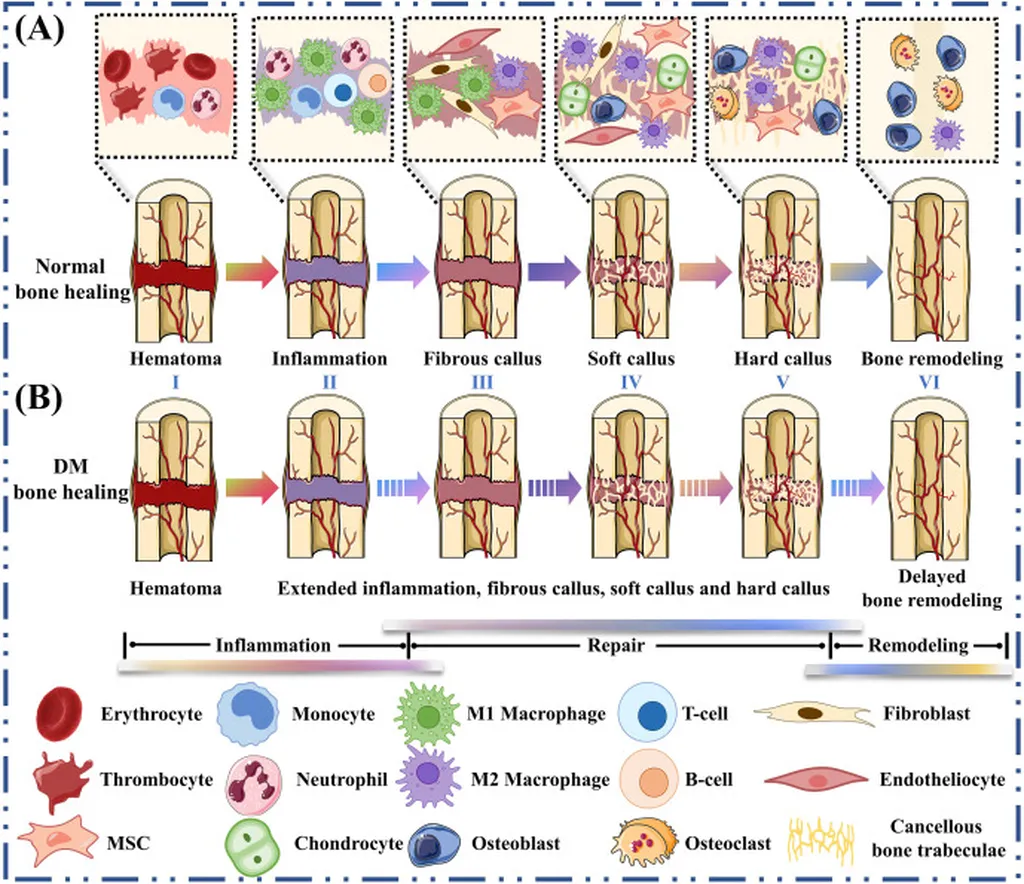In the realm of medical science, a groundbreaking study led by Dr. Xudong Xie from the Department of Orthopedics at Union Hospital, Tongji Medical College, has unveiled a novel approach to tackle diabetic bone regeneration. The research, published in the esteemed journal *Bioactive Materials* (translated as *活性材料*), introduces a bone-targeted nanoplatform, AgSr-MSNs, designed to address the chronic inflammation, vascular insufficiency, and osteogenic impairment associated with diabetic osteopathy.
Diabetes is known to impair bone regeneration due to dysregulated macrophage polarization and inflammatory imbalance. Current therapies often fall short in addressing these systemic issues. Dr. Xie’s team has engineered a nanoplatform that scavenges excess nitric oxide (NO) and responds to the acidic diabetic microenvironment. This innovative system integrates silver sulfide quantum dots (Ag2S QDs) and Sr2+ into mesoporous silica nanoparticles (MSNs), encapsulated with rhodamine/β-cyclodextrin and surface-modified with alendronate for bone-specific targeting.
Under near-infrared (NIR) irradiation, the nanoparticles induce macrophage repolarization toward M2 phenotypes through the JAK/STAT signaling pathway. This process upregulates anti-inflammatory mediators and tissue-regenerative factors while suppressing pro-inflammatory cytokines. “This dual NO/pH-responsive platform synergistically mitigates inflammatory dysregulation, enhances osteogenesis, and promotes angiogenesis,” explains Dr. Xie.
The implications of this research are profound. In diabetic models, systemic administration with NIR-mediated mild hyperthermia has been shown to reduce CD86+ macrophages and TNF-α levels while elevating CD206+ macrophages locally and systemically. Concurrently, it boosts CD31, Runx2, and osteocalcin (OCN) expression levels at defect sites, indicating restored vascularization and osteogenesis.
The commercial impacts of this research could be significant, particularly in the energy sector. As the population ages and the prevalence of diabetes continues to rise, the demand for effective bone regeneration therapies will only increase. This innovative nanotherapeutic paradigm could provide a much-needed solution, addressing the pathological triad of diabetic osteopathy and improving the quality of life for millions of patients worldwide.
Dr. Xie’s work not only advances our understanding of diabetic bone regeneration but also paves the way for future developments in the field. As the research continues to evolve, it holds the potential to revolutionize the way we approach metabolic bone disorders, offering hope for a healthier future.
In the words of Dr. Xie, “This strategy addresses the pathological triad of diabetic osteopathy—chronic inflammation, vascular insufficiency, and osteogenic impairment—providing a translatable nanotherapeutic paradigm for metabolic bone disorders.” The journey towards effective diabetic bone regeneration has taken a significant step forward, and the future looks promising.

